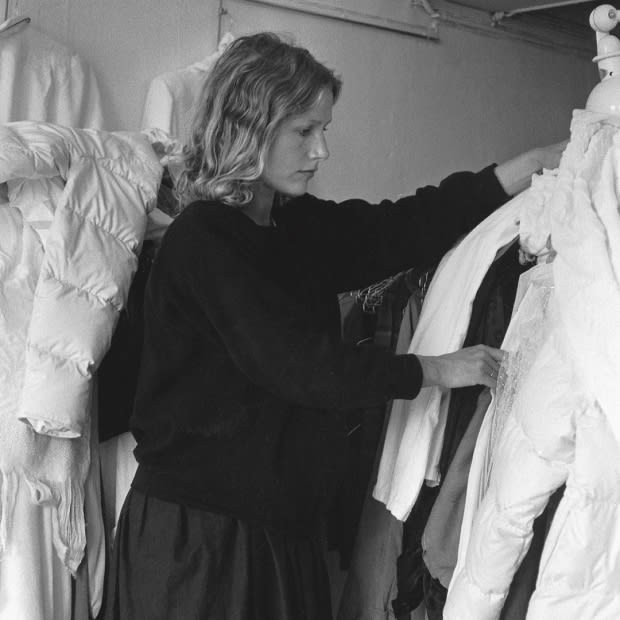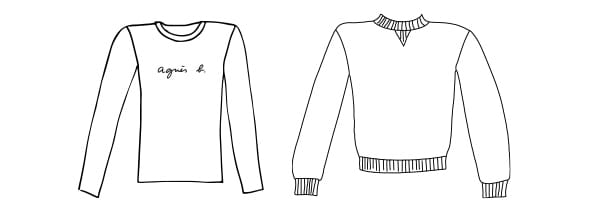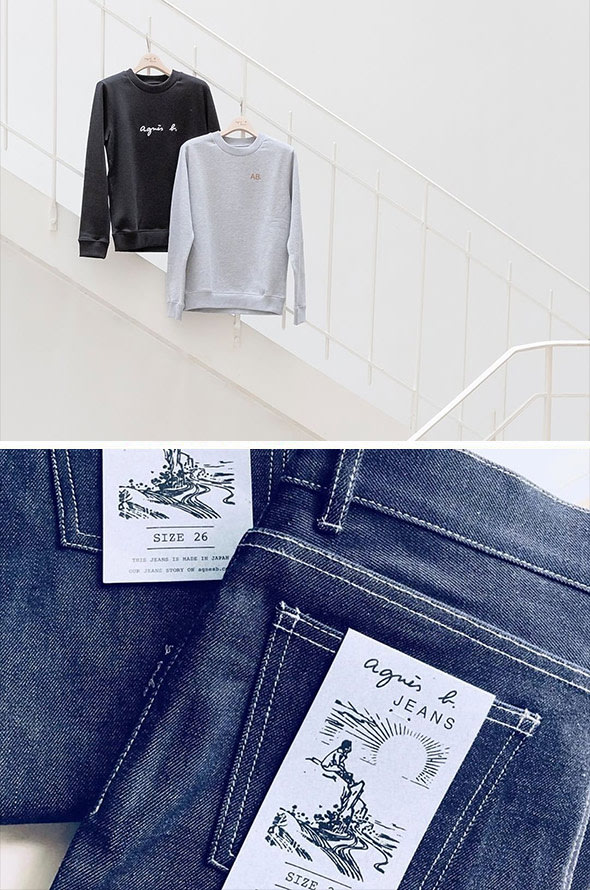Useful tips
-
How to care of your clothes
This booklet has been designed to help you keep your Agnès b. clothes as beautiful as the day you bought them while taking care of our planet. Agnès b. creates timeless clothes that can be worn from generation to generation; the opposite of fast, disposable fashion which encourages us to over-consume clothes.
As well as the style and quality of the garments offered by agnès, one of the secrets of the durability of a garment is good maintenance over the years. We hope this little guide will help you to take good care of your clothes and will help you discover tips and tricks.
We hope you enjoy reading and prolonging the lifespan of your special purchase.


The 11 golden rules for sustainable and more environmentally friendly clothes care.
#1 · Always read the washing instructions indicated on the hangtag of your garment.
#2 · Only wash your clothes when necessary. Washing pollutes and consumes a lot of water and energy. What's more, washing synthetic materials, such as nylon, polyester or elastane, releases plastic microparticles into wastewater, which end up in the oceans.
#3 · Wait until you have a full load before doing the washing. However, avoid overloading the machine, so the clothes have room to move in the machine. Always leave a space, approximately the width of a hand width, between the top of the drum and the clothes.
#4 · Wash at 30°C whenever possible: most of our textiles can be washed at 30°C. By washing at 30°C instead of 60°C, you can make energy savings of over 60% per wash. It also reduces limescale deposits and extends the life of your washing machine.
#5 · Use environmentally friendly detergents. For more sustainable cleaning. You can also make your own detergent with natural products.
#6 · Choose detergents without bleach or brighteners for all coloured items.
#7 · Avoid strongly scented detergents and softeners as they can be highly polluting. They can also be a source of allergies when they make contact with the skin.
#8 · Use a low spin speed, to prevent the garment from shrinking or pilling.
#9 · As far as possible dry your clothes naturally. Avoid using tumble dryers, which consume a lot of energy and may damage the clothing fibres.
#10 · Only use professional cleaning if it is recommended on your garment hangtag.
#11 · Repair your clothes should it become necessary

Following these guidelines will help extend the lifecycle of your clothes.
One of the main values of agnes b; designing clothes that last a lifetime.


Our care advice for each fabrics
For all the raw materials, we recommend that you refer to the care instructions on the garment label.
COTTON
Wash at 30°C if it’s possible (the temperatures indicated on the hangtag are maximum temperatures). Wash the garment inside out.
CREPE
To preserve the crepe look of your garment, dry it on a hanger and steam the surface of the fabric, without direct contact with the iron. Ironing will cancel the crepe effect.


LEATHER
To preserve your collar in leather, avoid contact with cosmetics products such as: hair gel, cosmetic cream, perfume and hair spray
To clean leather, quickly apply a clay-based stain remover called ‘Terre de Sommières’, which can be used to absorb grease stains (except indelible ink stains), but seek professional advice. Never use aggressive products designed for shoes and furniture.
JEAN
The colour of the denim can bleed simply by rubbing against lighter materials, so we advise to wash jeans separately. Wash jeans inside out , limiting as far as possible the number of washes. Iron at 150°C except when the fabric content contains elastane. In this case, ironing must not exceed 110°C. Machine drying is not recommended.
FLEECE, JERSEY
Wash and iron inside out. After the spin ,gently shape the garment. Dry it on a hanger.
WOOL, ALPACA WOOL, MERINO WOOL, CASHMERE
Wash your garment after wearing it 2 or 3 times to remove the excess material and make it even softer. Wash it with a low dose of pH-neutral detergent, without fabric softener, at 30°C, by hand or machine (wool programme), with a spin cycle of 400 rpm. Shape the garment before drying it flat, away from direct light. Iron with a cool iron. Avoid soaking and wringing. Always refer to the washing instructions on the garment label. Properly cared for, your garment will become increasingly beautiful and soften over time.
LINEN
A linen garment may have a few irregularities that give it its authenticity and unique character. We recommend that you wash it according to the hangtag washing instructions.


POLYESTER
Washing clothes made from synthetic materials such as polyester releases plastic microparticles into wastewater, polluting the oceans. To limit this release of micro-particles, start your washing machine with a full drum and avoid washing the clothes concerned above 30°C. Spin at a low speed then air dry.
POPELIN
Iron the poplin inside out.
SILK
Wash your garment in cold water (maximum 30°C) with a mild detergent and fabric softener, then hang it out to dry. Iron whilst damp.
CHEESE CLOTH
Dry naturally, avoiding the tumble dryer.
VELVET
Wash and iron the garment inside out.
VISCOSE
Wash inside out and use a low spin programme.

agnès b.'s secrets
The agnès b. style also includes pieces that have become iconic and must haves staples in any wardrobe. Let's take a look at them and their secrets...

SNAPS CARDIGANS
-
By cutting up a sweatshirt to make a cardigan, agnès b. created the snap cardigan in 1979. Since then, it's been worn the world over!
Care instructions: We recommend washing and ironing all your fleece and jersey garments inside out. Pull the garment taut after spinning to restore its shape. Preferably dry on a hanger.
SCREEN-PRINTED CLOTHES
-
Agnès b. often uses silk-screen printing for her ‘artists t shirts’ , (created in 1994), and her message t-shirts for women, men and children.
Care instructions: Do not wash your screen-printed t-shirts and garments at more than 30°C. Lie them flat after washing. Iron them inside out.
STRIPED SHIRTS
-
From the “Marinière” she first created in the fabric of a rugby polo shirt which remains in the collection to this day, to the ever-new prints that appear on her clothes, agnès b. sees life in colour.
Care instructions: To preserve the colours, do not soak your striped t shirts after spin-drying. As with screen prints, lie them flat as soon as the machine is finished and iron them inside out.
Care symbols
Before cleaning or ironing a garment, always refer to the care symbols on the hangtag sewn into the side or back of the garment.
WASH






TUMBLE DRY



IRONING






DRY CLEANING
Garments marked with one of these symbols must be cleaned exclusively ata dry cleaners. Each symbol indicates the type of treatment to be applied by the service provider. It has contractual value, and failure to comply will entitle you to be refunded by your dry cleaner in the event of damage. It is therefore essential to keep the labels and purchase receipts for this type of clothing. For your information, we indicate the meaning of each of these symbols, which are difficult for non-specialists to understand.



Still in doubt? clevercare.info
Tips and advice...

Stain removal is the local removal of a stain that may not wash out or that you have made on a garment that needs to be professionally washed. It can be a thick stain (chocolate, paint, blood, food), or a liquid stain (fruit juice, wine, alcohol, coffee). To treat this type of stain, it's always best to contact a professional, such as a dry cleaner, and take the garment to them as quickly as possible.
However, here are a few tips to help you try stain removal yourself if you wish:
Avoid using any heat before stain removal (hot washing for example) as there is a risk of ‘cooking’ the stain. Start by removing the stain,by brushing it out if it's hard or dry, by scraping it with a round knife if it's viscous, by absorbing it with a white cotton cloth or kitchen towel if it's liquid (place another piece of paper inside the garment and pat it out). In all cases, do not rub the stain, to avoid embedding it in the fibre. Before pouring the stain remover, make sure that the fibre and colours are not affected by the product used on a hidden part of the garment (hem, for example).
When choosing a product, refer to the garment's composition label: never use bleach on wool, silk and viscose, polyamides, polyesters, acrylics and elastanes. Never use salt or white vinegar. Avoid using water on ink stains. In addition to commercially available stain removers, you can use soda water, ammonia, alcohol and white spirit. Never apply the stain remover directly to the stain: pour it onto a cloth or paper towel and pat lightly without
rubbing, or place a cloth soaked in the product inside the garment. Once the stain has been absorbed, dry it with a clean cloth. If a’tidemark’ remains, steam the stain.
Then wash the garment according to the instructions on the label.

Use a detergent specifically for hand washing and where appropriate, one specifically for wool. Always wash in cold water without rubbing, do not leave to soak, then rinse several times in clean water. Gently pull the garment back into shape, then lay it flat, avoiding direct contact with a strong source of heat or light (sun, radiator, etc.).

Use a detergent specifically for hand washing and where appropriate, one specifically for wool. Always wash in cold water without rubbing, do not leave to soak, then rinse several times in clean water. Gently pull the garment back into shape, then lay it flat, avoiding direct contact with a strong source of heat or light (sun, radiator, etc.).

Drying naturally is always preferable. Before tumble-drying a garment, check the care label to make sure that this is recommended.. Don't forget that, even when stated, tumble drying can cause felting and alter the garment's proportions. It consumes a lot of energy, which is a source of greenhouse gas emissions. For conventional drying, dry coloured garments inside out, and heavy garments folded to prevent distortion. Some garments and fibres have a tendency to warp, so stretch them gently before drying to help them regain their shape.

The type of fabric will usually determine the ironing temperature: refer to the garment care label to set your iron. As a general rule, ironing on the reverse side is preferable for all fabrics. It is also advisable to apply a damp cotton cloth between the garment and the iron, particularly for fragile fabrics or fabrics that are likely to shine.
Always iron screen prints on the reverse side. Ironing them on the right side will permanently damage them. Don't forget to clean your iron soleplate before it has cooled down completely, to avoid residues that could stain your clothes the next time you iron.

Frequently asked questions

How to remove a grease stain ?
Soak the stain for 24 hours with terre de Sommières or soak it with damp Marseille soap, then leave to dry and wash.
How to remove an oil stain ?
Apply dishwashing liquid to soak the fabric and then wash.
How to remove a fresh blood stain ?
Soak the bloodstain in cold water for 12 hours, then wash.
How to remove a dried bloodstain ?
Place the stained side on a paper towel and soak the back of the fabric with a mixture of cold water and hydrogen peroxide.
Repeat the operation several times and then wash.
How to remove a dry red wine stain ?
Make a paste-like mixture on the wine stain with lemon and bicarbonate or white vinegar and bicarbonate.
Leave it to work, then add water and repeat the operation if necessary.
How to wash a down jacket ?
If the down jacket is washable: wash at 30°C (40°C max) with liquid detergent and 2 tennis balls.
If tumble drying is recommended: also add 2 tennis balls to optimise the loft.
How to wash a cap ?
It all depends on the composition and assembly. For a plain 100% cotton cap: wash at 30°C.

agnès b. philosophy
-
Agnès b. quality is achieved by an extensive search for the best materials and the best weavers, predominantly in France, Italy and Belgium. All our fabrics are exclusive. Both comfort and feel are essential criteria in our decision making process. The prints are developed for agnès b., often based on an idea or drawing by the designer herself. Agnès b. has always supported made in France:
"We have been manufacturing in France since the creation of the brand in 1973, because throughout France, we have the know-how, manufacturing capabilities and very skilled people”, Agnès points out.
Sadly today we are unable to manufacture the entire collection in France as some factories have moved production to other countries .however, agnes b. Still produces more than 30% of her collections throughout France with the vast majority of the rest being produced throughout Europe. Wherever the clothes are made, it is always with artisans who have the ‘savoir faire’ to reach the high quality we require and who meet our social and environmental standards. We consider these artisans who we have worked with for a very long time as very special partners.